Abstract
We measured basal and peak acid outputs, food-stimulated acid secretion, and basal and food-stimulated serum gastrin concentrations in a large group of duodenal ulcer patients and normal subjects. Basal and peak acid outputs were significantly higher in ulcer patients. In contrast, acid secretion was similar in the groups when food was infused into the stomach and when sham feeding was combined with meal infusion to simulate normal eating. Meal-stimulated acid secretion, expressed as a percentage of peak acid output to correct for differences in secretory capacity, was lower in ulcer patients (P less than 0.002). Basal serum gastrin concentrations were higher in ulcer patients, which may have contributed to higher basal acid output. However, increases in serum gastrin after food were similar in the groups. Duodenal ulcer patients, as a group, have increased basal and maximal acid secretion, but the amount of acid secreted and gastrin released after eating is normal.
Full text
PDF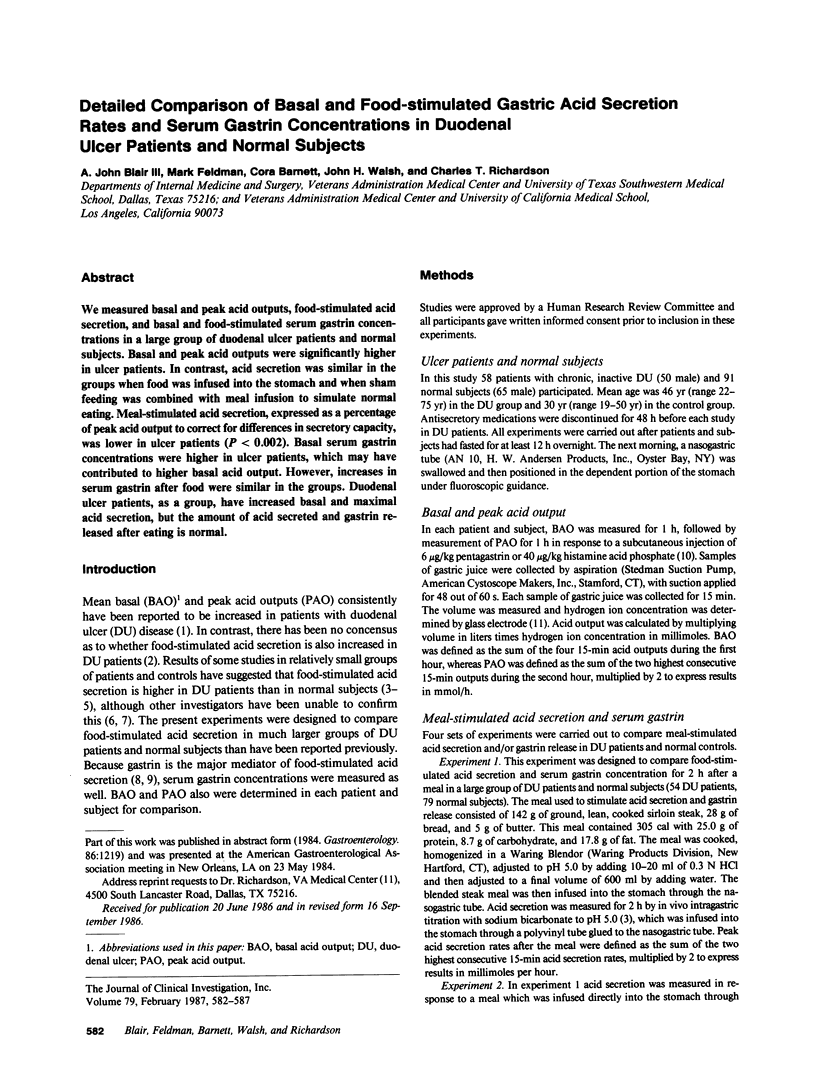
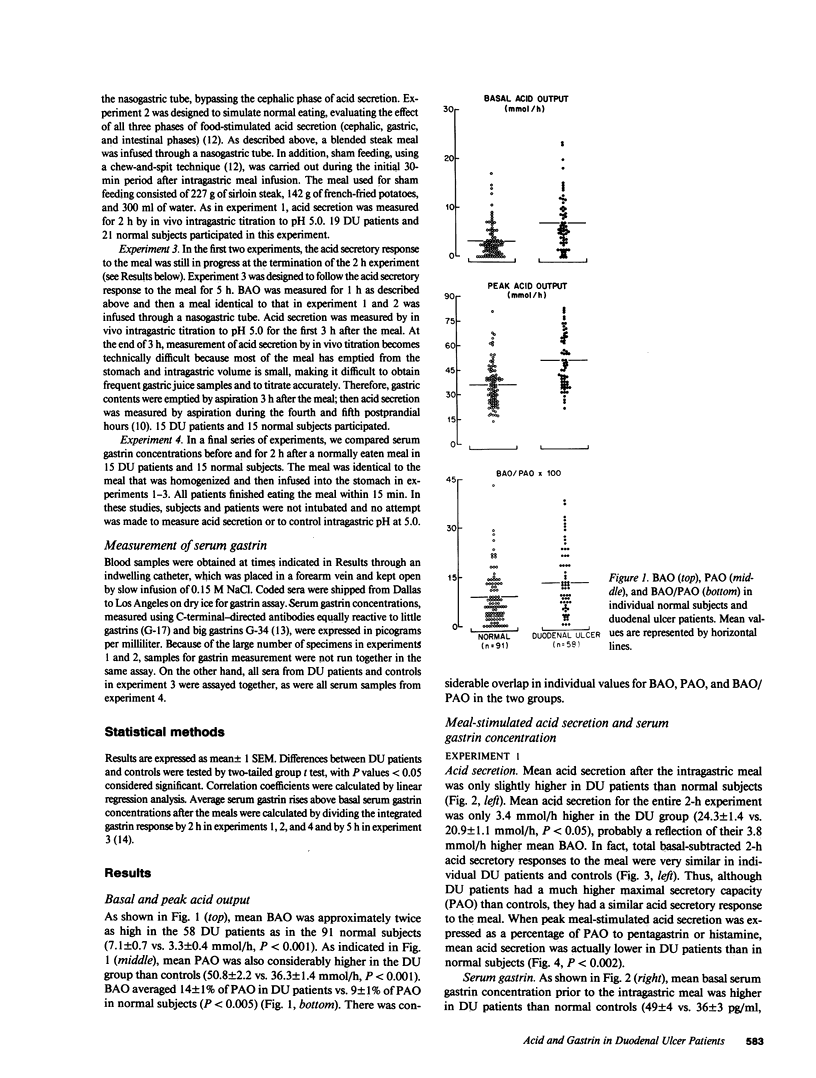
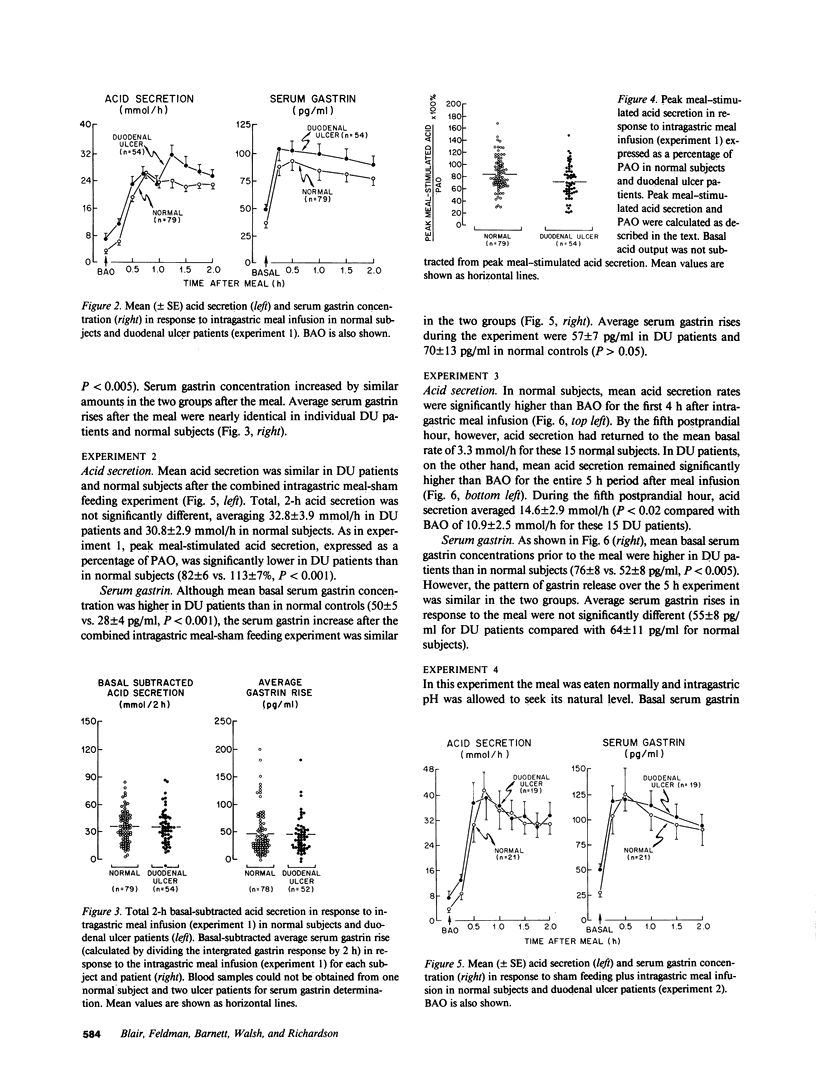
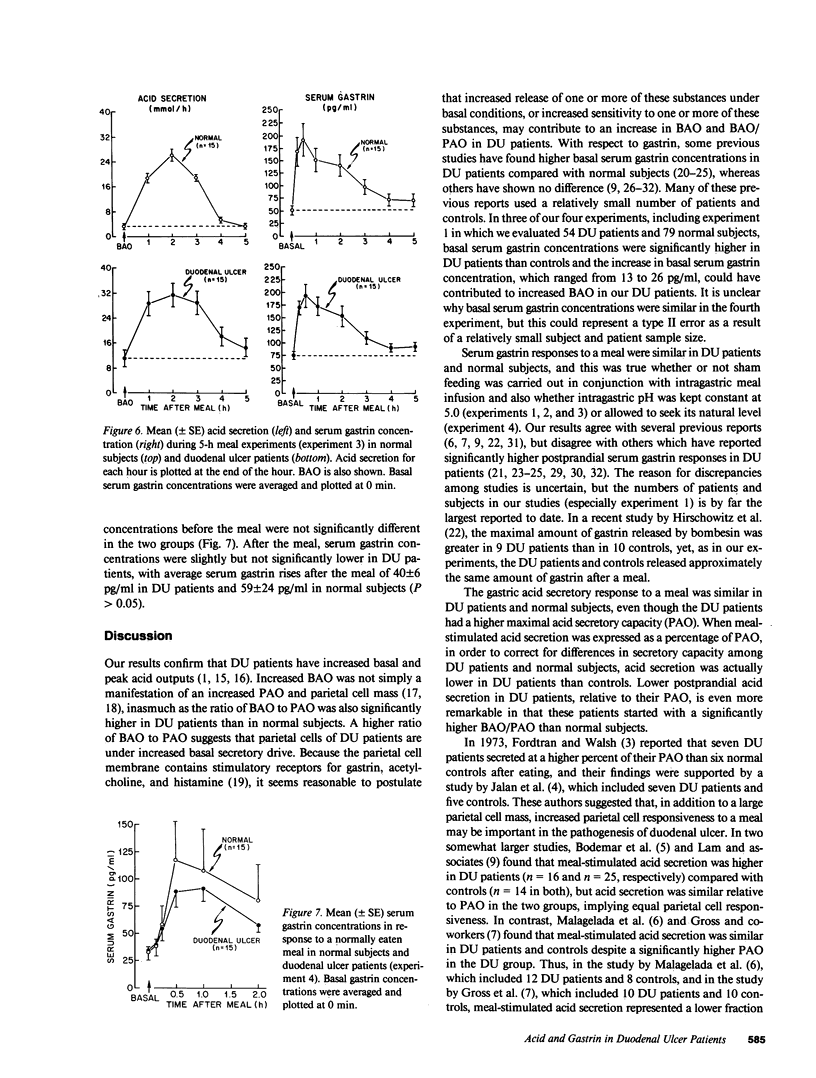

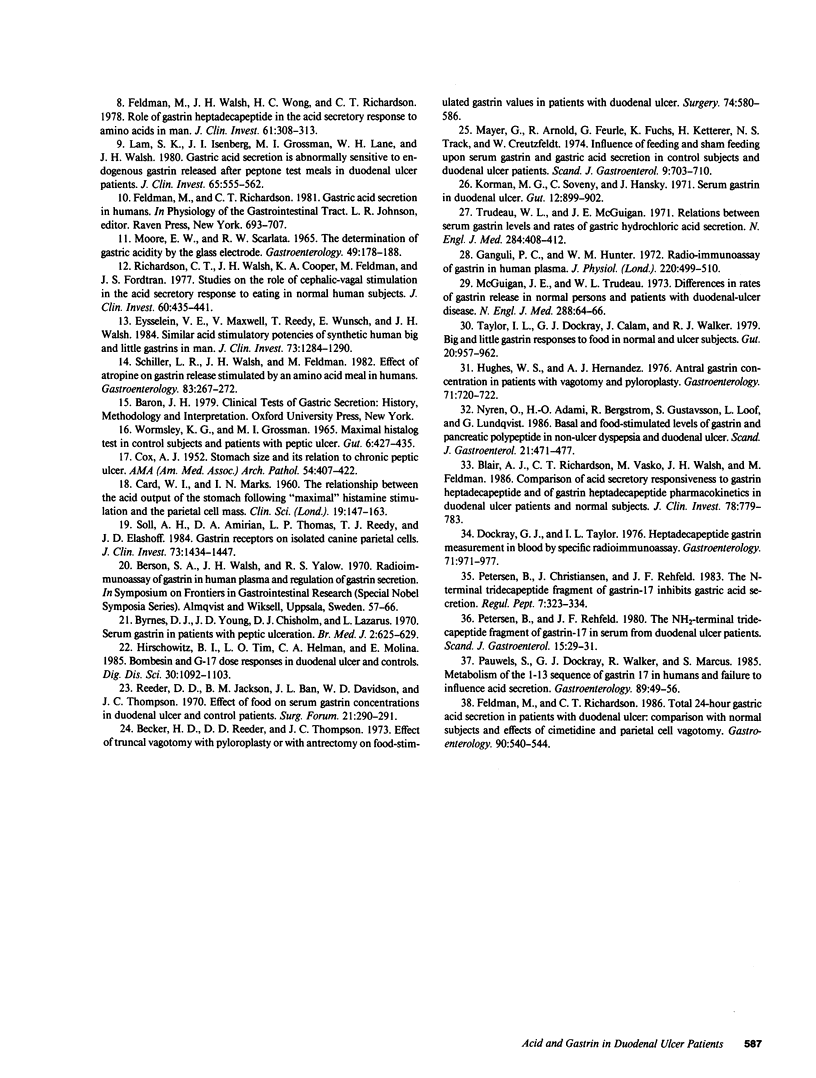
Selected References
These references are in PubMed. This may not be the complete list of references from this article.
- Becker H. D., Reeder D. D., Thompson J. C. Effect of truncal vagotomy with pyloroplasty or with antrectomy on food-stimulated gastrin values in patients with duodenal ulcer. Surgery. 1973 Oct;74(4):580–586. [PubMed] [Google Scholar]
- Blair A. J., 3rd, Richardson C. T., Vasko M., Walsh J. H., Feldman M. Comparison of acid secretory responsiveness to gastrin heptadecapeptide and of gastrin heptadecapeptide pharmacokinetics in duodenal ulcer patients and normal subjects. J Clin Invest. 1986 Sep;78(3):779–783. doi: 10.1172/JCI112640. [DOI] [PMC free article] [PubMed] [Google Scholar]
- Bodemar G., Walan A., Lundquist G. Food-stimulated acid secretion measured by intragastric titration with bicarbonate in patients with duodenal and gastric ulcer disease and in controls. Scand J Gastroenterol. 1978;13(8):911–918. doi: 10.3109/00365527809181368. [DOI] [PubMed] [Google Scholar]
- Byrnes D. J., Young J. D., Chisholm D. J., Lazarus L. Serum gastrin in patients with peptic ulceration. Br Med J. 1970 Jun 13;2(5710):626–629. doi: 10.1136/bmj.2.5710.626. [DOI] [PMC free article] [PubMed] [Google Scholar]
- CARD W. I., MARKS I. N. The relationship between the acid output of the stomach following "maximal" histamine stimulation and the parietal cell mass. Clin Sci. 1960 Feb;19:147–163. [PubMed] [Google Scholar]
- COX A. J. Stomach size and its relation to chronic peptic ulcer. AMA Arch Pathol. 1952 Nov;54(5):407–422. [PubMed] [Google Scholar]
- Dockray G. J., Taylor I. L. Heptadecapeptide gastrin: measurement in blood by specific radioimmunoassay. Gastroenterology. 1976 Dec;71(6):971–977. [PubMed] [Google Scholar]
- Eysselein V. E., Maxwell V., Reedy T., Wünsch E., Walsh J. H. Similar acid stimulatory potencies of synthetic human big and little gastrins in man. J Clin Invest. 1984 May;73(5):1284–1290. doi: 10.1172/JCI111330. [DOI] [PMC free article] [PubMed] [Google Scholar]
- Feldman M., Richardson C. T. Total 24-hour gastric acid secretion in patients with duodenal ulcer. Comparison with normal subjects and effects of cimetidine and parietal cell vagotomy. Gastroenterology. 1986 Mar;90(3):540–544. doi: 10.1016/0016-5085(86)91106-6. [DOI] [PubMed] [Google Scholar]
- Feldman M., Walsh J. H., Wong H. C., Richardson C. T. Role of gastrin heptadecapeptide in the acid secretory response to amino acids in man. J Clin Invest. 1978 Feb;61(2):308–313. doi: 10.1172/JCI108940. [DOI] [PMC free article] [PubMed] [Google Scholar]
- Fordtran J. S., Walsh J. H. Gastric acid secretion rate and buffer content of the stomach after eating. Results in normal subjects and in patients with duodenal ulcer. J Clin Invest. 1973 Mar;52(3):645–657. doi: 10.1172/JCI107226. [DOI] [PMC free article] [PubMed] [Google Scholar]
- Ganguli P. C., Hunter W. M. Radio-immunoassay of gastrin in human plasma. J Physiol. 1972 Jan;220(2):499–510. [PMC free article] [PubMed] [Google Scholar]
- Gross R. A., Isenberg J. I., Hogan D., Samloff I. M. Effect of fat on meal-stimulated duodenal acid load, duodenal pepsin load, and serum gastrin in duodenal ulcer and normal subjects. Gastroenterology. 1978 Sep;75(3):357–362. [PubMed] [Google Scholar]
- Grossman M. I. Abnormalities of acid secretion in patients with duodenal ulcer. Gastroenterology. 1978 Sep;75(3):524–526. [PubMed] [Google Scholar]
- Hirschowitz B. I., Tim L. O., Helman C. A., Molina E. Bombesin and G-17 dose responses in duodenal ulcer and controls. Dig Dis Sci. 1985 Nov;30(11):1092–1103. doi: 10.1007/BF01315608. [DOI] [PubMed] [Google Scholar]
- Hughes W. S., Hernandez A. J. Antral gastrin concentration in patients with vagotomy and pyloroplasty. Gastroenterology. 1976 Nov;71(5):720–722. [PubMed] [Google Scholar]
- Jalan K. N., Mahalanabis D., Maitra T. K., Agarwal S. K. Gastric acid secretion rate and buffer content of the stomach after a rice- and a wheat-based meal in normal subjects and patients with duodenal ulcer. Gut. 1979 May;20(5):389–393. doi: 10.1136/gut.20.5.389. [DOI] [PMC free article] [PubMed] [Google Scholar]
- Korman M. G., Soveny C., Hansky J. Serum gastrin in duodenal ulcer. I. Basal levels and effect of food and atropine. Gut. 1971 Nov;12(11):899–902. doi: 10.1136/gut.12.11.899. [DOI] [PMC free article] [PubMed] [Google Scholar]
- Lam S. K., Isenberg J. I., Grossman M. I., Lane W. H., Walsh J. H. Gastric acid secretion is abnormally sensitive to endogenous gastrin released after peptone test meals in duodenal ulcer patients. J Clin Invest. 1980 Feb;65(2):555–562. doi: 10.1172/JCI109699. [DOI] [PMC free article] [PubMed] [Google Scholar]
- MOORE E. W., SCARLATA R. W. THE DETERMINATION OF GASTRIC ACIDITY BY THE GLASS ELECTRODE. Gastroenterology. 1965 Aug;49:178–188. [PubMed] [Google Scholar]
- Malagelada J. R., Longstreth G. F., Deering T. B., Summerskill W. H., Go V. L. Gastric secretion and emptying after ordinary meals in duodenal ulcer. Gastroenterology. 1977 Nov;73(5):989–994. [PubMed] [Google Scholar]
- Mayer G., Arnold R., Feurle G., Fuchs K., Ketterer H., Track N. S., Creutzfeldt W. Influence of feeding and sham feeding upon serum gastrin and gastric acid secretion in control subjects and duodenal ulcer patients. Scand J Gastroenterol. 1974 Nov;9(8):703–710. [PubMed] [Google Scholar]
- McGuigan J. E., Trudeau W. L. Differences in rates of gastrin release in normal persons and patients with duodenal-ulcer disease. N Engl J Med. 1973 Jan 11;288(2):64–66. doi: 10.1056/NEJM197301112880202. [DOI] [PubMed] [Google Scholar]
- Nyrén O., Adami H. O., Bergström R., Gustavsson S., Löf L., Lundqvist G. Basal and food-stimulated levels of gastrin and pancreatic polypeptide in non-ulcer dyspepsia and duodenal ulcer. Scand J Gastroenterol. 1986 May;21(4):471–477. doi: 10.3109/00365528609015164. [DOI] [PubMed] [Google Scholar]
- Pauwels S., Dockray G. J., Walker R., Marcus S. Metabolism of the 1-13 sequence of gastrin 17 in humans and failure to influence acid secretion. Gastroenterology. 1985 Jul;89(1):49–56. doi: 10.1016/0016-5085(85)90744-9. [DOI] [PubMed] [Google Scholar]
- Petersen B., Christiansen J., Rehfeld J. F. The N-terminal tridecapeptide fragment of gastrin-17 inhibits gastric acid secretion. Regul Pept. 1983 Dec;7(4):323–334. doi: 10.1016/0167-0115(83)90104-0. [DOI] [PubMed] [Google Scholar]
- Petersen B., Rehfeld J. F. The NH2-terminal tridecapeptide fragment of gastrin-17 in serum from duodenal ulcer patients. Scand J Gastroenterol. 1980;15(1):29–31. doi: 10.3109/00365528009181427. [DOI] [PubMed] [Google Scholar]
- Reeder D. D., Jackson B. M., Ban J. L., Davidson W. D., Thompson J. C. Effect of food on serum gastrin concentrations in duodenal ulcer and control patients. Surg Forum. 1970;21:290–291. [PubMed] [Google Scholar]
- Richardson C. T., Walsh J. H., Cooper K. A., Feldman M., Fordtran J. S. Studies on the role of cephalic-vagal stimulation in the acid secretory response to eating in normal human subjects. J Clin Invest. 1977 Aug;60(2):435–441. doi: 10.1172/JCI108793. [DOI] [PMC free article] [PubMed] [Google Scholar]
- Schiller L. R., Walsh J. H., Feldman M. Effect of atropine on gastrin release stimulated by an amino acid meal in humans. Gastroenterology. 1982 Jul;83(1 Pt 2):267–272. [PubMed] [Google Scholar]
- Soll A. H., Amirian D. A., Thomas L. P., Reedy T. J., Elashoff J. D. Gastrin receptors on isolated canine parietal cells. J Clin Invest. 1984 May;73(5):1434–1447. doi: 10.1172/JCI111348. [DOI] [PMC free article] [PubMed] [Google Scholar]
- Taylor I. L., Dockray G. J., Calam J., Walker R. J. Big and little gastrin responses to food in normal and ulcer subjects. Gut. 1979 Nov;20(11):957–962. doi: 10.1136/gut.20.11.957. [DOI] [PMC free article] [PubMed] [Google Scholar]
- Trudeau W. L., McGuigan J. E. Relations between serum gastrin levels and rates of gastric hydrochloric acid secretion. N Engl J Med. 1971 Feb 25;284(8):408–412. doi: 10.1056/NEJM197102252840803. [DOI] [PubMed] [Google Scholar]
- Wormsley K. G., Grossman M. I. Maximal histalog test in control subjects and patients with peptic ulcer. Gut. 1965 Oct;6(5):427–435. doi: 10.1136/gut.6.5.427. [DOI] [PMC free article] [PubMed] [Google Scholar]


